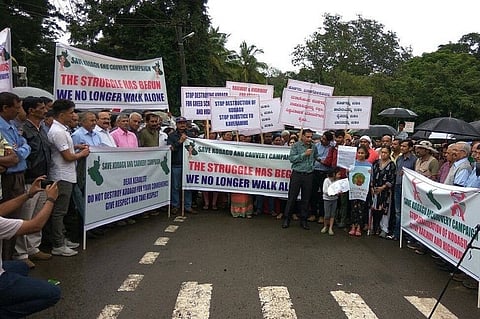

A movement is growing in the hilly region of Kodagu, Karnataka’s only district without a railway network, to stop a proposed rail line from being constructed.
The project involves a railway line connecting Mysuru to Kushalnagar, one of the last towns in the plains, and onwards to Madikeri, the capital of Kodagu, and another connecting Mysuru and Thalassery in Kerala.
The mooted project was earlier shelved after the Congress-led United Progressive Alliance (UPA) government undertook a preliminary survey in 2011. They concluded that the route would be unprofitable.
But the project was revived at the end of 2011, when a new survey was commissioned by then Union Minister for State Railways KH Muniyappa, after BJP’s BS Yeddyurappa promised to bear 50% of the costs of the proposed railway line.
The survey was approved in 2014 by Railway Minister Sadanand Gowda, part of the newly formed BJP-led National Democratic Alliance government at the centre. The new survey was completed despite protests in the district by activists and citizens earlier this year.
Train to Kushalnagar n Thanks to @sureshpprabhu pic.twitter.com/zHUhDpEIAC
— Pratap Simha (@mepratap) February 25, 2016
History of the proposed rail project
The first attempt to connect Mysore and Tellicherry (present day Thalassery) via Madikeri by rail dates back to 1881-82, according to government reports citing the Kodagu Gazetteer. The report notes a letter dated 17.03.1883 from the Commissioner of Kodagu written to the Mysore Chief Commissioner’s Secretary proposing a railway line. A preliminary survey was conducted but the railway line never materialised as the plan was deemed unfeasible.
After Independence, the plan to connect Kodagu by rail was brought up several times after it became a province of the Indian Union. In 1956, Kodagu was merged with the state of Mysore although Kodavas who live in Kodagu speak a distinct language and do not speak Kannada.
Even when former CM Poonacha, a native of Kodagu became Cabinet Minister for Railways in 1967, he opposed the plans stating that rail connectivity would not be in the long-term interests of Kodagu.
It was only in 2011 that a fresh preliminary survey was commissioned to explore the possibility of a railway line. The proposed railway line was later included in the 2016-17 Railway Budget and the survey commissioned by the NDA government was completed in September 2016 despite opposition from environmentalists and local citizens.
The growing opposition spiralled into full-fledged protests coordinated by Coorg Wildlife Society and a large number of organisations including Kodagu Growers Federation, United Kodava Organisation, Coorg Wildlife Society and Saver River Cauvery Forum, under the banner of ‘Save Kodagu’ and ‘Save Cauvery’ campaigns. The first protest was held in Madikeri on June 4 and the second was held at Kutta on August 26. A Change.Org petition to the Karnataka State Minister for Environment, Prakash Javadekar, has registered over 23,000 signatures.
Threat to elephants?
Locals and environmentalists oppose the railway line over fears of continued environmental damage to the forests of Kodagu, noting that thousands of trees will be cut down in the Cauvery catchment area to build the railway line. They also fear that problems of conflict between local farmers and elephants will be exacerbated. Activists point out that elephant calves will not be able to walk freely in areas where railway lines will be constructed since they will be built on embankments up to four metres high.
While the railway line was pushed through with the premise of boosting tourism in the district, environmentalists pointed out that Kodagu was overburdened with tourists and there was a need to regulate the number of tourists visiting the district rather than increase it.
Kodagu - a communal tinderbox?
In a letter to present Railway Minister CP Goyal, President of the Coorg Wildlife Society Col C P Muthanna also raised the possibility of internal security problems due to influx of migrants. Drawing attention to the communal clashes in 2015 during Tipu Jayanti, Col Muthanna said that a proposed railway line could turn Kodagu into a communal tinderbox since it borders communally sensitive districts in Kerala.
While the central government remains firmly in favour of enforcing a railway line through Kodagu, the district minister in-charge MR Seetharaman remains opposed to the plans. Activists also pointed out that Karnataka Congress In-Charge KC Venugopal, one of the proponents of the railway line connecting Kerala and Mysuru, is originally from Kerala. He was also instrumental in forging the 400 kV power line from Mysore to Kozhikode via Kodagu in 2014.
The Karnataka state government meanwhile has written a letter to the Central government against taking up railway projects in the district. MLA KG Bopaiah of the BJP, however, seeks to reach a compromise by constructing the railway line only till Kushalnagar.
Activism is building against the unpopular project with environmentalists suggesting alternatives to the proposed railway line. “The money being spent on the railway line could be used to protect the environment and help sustain local communities and support coffee and pepper growers in Kodagu. This can be done by providing incentives for maintaining indigenous tree species in private lands and provide subsidies for beekeeping, floriculture and also by setting up industries such as pepper processing plants to provide employment to local people,” said Col Muthanna, President of the Coorg Wildlife Society.